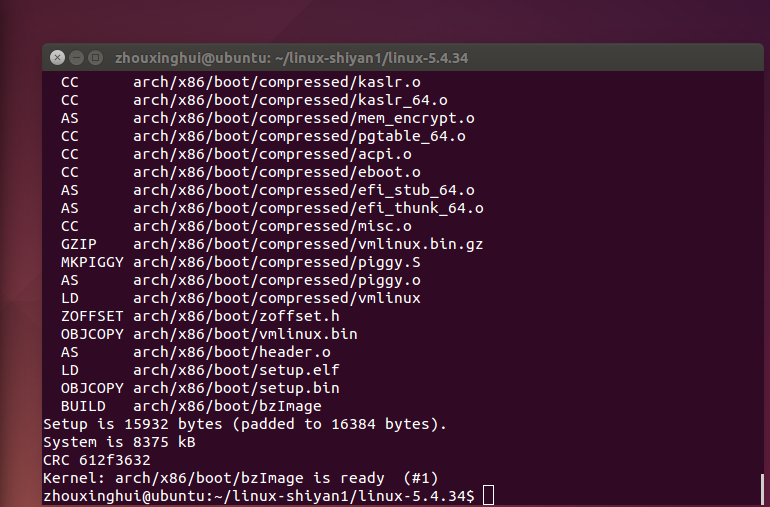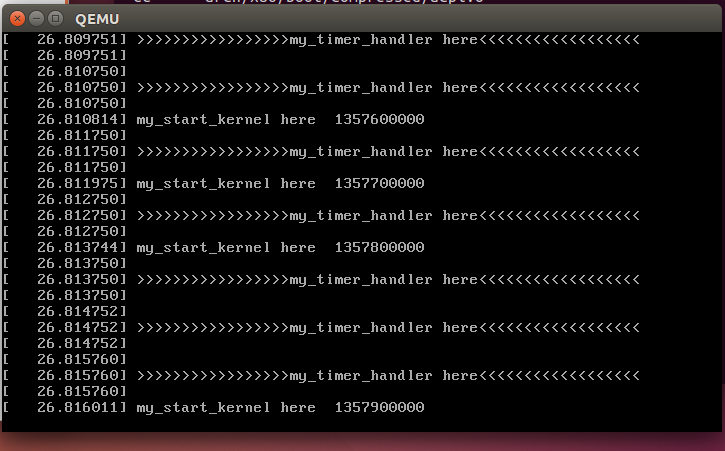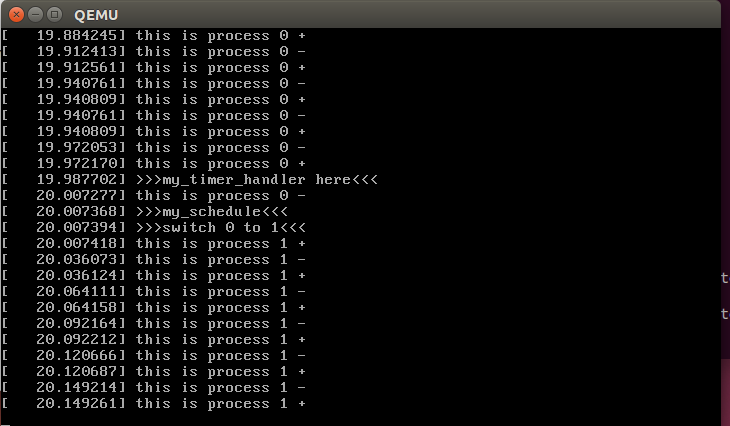基于mykernel 2.0编写一个操作系统内核
配置mykernel 2.0,熟悉Linux内核的编译
1.下载补丁和内核源码,解压内核源码
wget https://raw.github.com/mengning/mykernel/master/mykernel-2.0_for_linux-5.4.34.patch sudo apt install axel axel -n 20 https://mirrors.edge.kernel.org/pub/linux/kernel/v5.x/linux-5.4.34.tar.xz xz -d linux-5.4.34.tar.xz tar -xvf linux-5.4.34.tar
2.进入内核文件夹linux-5.4.34,在内核中打补丁
cd linux-5.4.34 patch -p1 < ../mykernel-2.0_for_linux-5.4.34.patch
3.安装编译工具和qemu虚拟机
sudo apt install build-essential libncurses-dev bison flex libssl-dev libelf-dev
sudo apt install qemu
4.配置编译内核生成bzImage文件
make defconfig
make -j4

5.虚拟机启动内核
qemu-system-x86_64 -kernel arch/x86/boot/bzImage

基于mykernel 2.0编写一个操作系统内核
1.在mykernel目录下增加一个mypcb.h 头文件,定义进程控制块PCB结构体
#define MAX_TASK_NUM 4 #define KERNEL_STACK_SIZE 1024*2 /* CPU-specific state of this task */ struct Thread { unsigned long ip; unsigned long sp; }; typedef struct PCB{ int pid; volatile long state; /* -1 unrunnable, 0 runnable, >0 stopped */ unsigned long stack[KERNEL_STACK_SIZE]; /* CPU-specific state of this task */ struct Thread thread; unsigned long task_entry; struct PCB *next; }tPCB; void my_schedule(void);
2.修改mymain.c中的my_start_kernel函数。添加my_process函数,此函数相当于一个进程,它的工作就是输出正在执行的进程的编号,并判断时间片是否用完来控制进程的调度。
#include <linux/types.h> #include <linux/string.h> #include <linux/ctype.h> #include <linux/tty.h> #include <linux/vmalloc.h> #include "mypcb.h" tPCB task[MAX_TASK_NUM]; tPCB * my_current_task = NULL; volatile int my_need_sched = 0; void my_process(void); void __init my_start_kernel(void) { int pid = 0; int i; /* Initialize process 0*/ task[pid].pid = pid; task[pid].state = 0;/* -1 unrunnable, 0 runnable, >0 stopped */ task[pid].task_entry = task[pid].thread.ip = (unsigned long)my_process; task[pid].thread.sp = (unsigned long)&task[pid].stack[KERNEL_STACK_SIZE-1]; task[pid].next = &task[pid]; /*fork more process */ for(i=1;i<MAX_TASK_NUM;i++) { memcpy(&task[i],&task[0],sizeof(tPCB)); task[i].pid = i; task[i].thread.sp = (unsigned long)(&task[i].stack[KERNEL_STACK_SIZE-1]); task[i].next = task[i-1].next; task[i-1].next = &task[i]; } /* start process 0 by task[0] */ pid = 0; my_current_task = &task[pid]; asm volatile( "movq %1,%%rsp\n\t" /* set task[pid].thread.sp to rsp */ "pushq %1\n\t" /* push rbp */ "pushq %0\n\t" /* push task[pid].thread.ip */ "ret\n\t" /* pop task[pid].thread.ip to rip */ : : "c" (task[pid].thread.ip),"d" (task[pid].thread.sp) /* input c or d mean %ecx/%edx*/ ); } int i = 0; void my_process(void) { while(1) { i++; if(i%10000000 == 0) { printk(KERN_NOTICE "this is process %d -\n",my_current_task->pid); if(my_need_sched == 1) { my_need_sched = 0; my_schedule(); } printk(KERN_NOTICE "this is process %d +\n",my_current_task->pid); } } }
3.修改myinterupt.c ,使用my_timer_handler模拟时间片,连续被调用1000次就是一个时间片。使用my_schedule函数完成上下文切换,my_schedule函数中的汇编代码是进程上下文切换的关键代码。
#include <linux/types.h> #include <linux/string.h> #include <linux/ctype.h> #include <linux/tty.h> #include <linux/vmalloc.h> #include "mypcb.h" extern tPCB task[MAX_TASK_NUM]; extern tPCB * my_current_task; extern volatile int my_need_sched; volatile int time_count = 0; /* * Called by timer interrupt. * it runs in the name of current running process, * so it use kernel stack of current running process */ void my_timer_handler(void) { if(time_count%1000 == 0 && my_need_sched != 1) { printk(KERN_NOTICE ">>>my_timer_handler here<<<\n"); my_need_sched = 1; } time_count ++ ; return; } void my_schedule(void) { tPCB * next; tPCB * prev; if(my_current_task == NULL || my_current_task->next == NULL) { return; } printk(KERN_NOTICE ">>>my_schedule<<<\n"); /* schedule */ next = my_current_task->next; prev = my_current_task; if(next->state == 0)/* -1 unrunnable, 0 runnable, >0 stopped */ { my_current_task = next; printk(KERN_NOTICE ">>>switch %d to %d<<<\n",prev->pid,next->pid); /* switch to next process */ asm volatile( "pushq %%rbp\n\t" /* save rbp of prev */ "movq %%rsp,%0\n\t" /* save rsp of prev */ "movq %2,%%rsp\n\t" /* restore rsp of next */ "movq $1f,%1\n\t" /* save rip of prev */ "pushq %3\n\t" "ret\n\t" /* restore rip of next */ "1:\t" /* next process start here */ "popq %%rbp\n\t" : "=m" (prev->thread.sp),"=m" (prev->thread.ip) : "m" (next->thread.sp),"m" (next->thread.ip) ); } return; }
重新编译运行,可以看到一个时间片用完后进行进程的切换

简要分析操作系统内核核心功能及运行工作机制
系统启动执行mymain.c中的my_start_kernal函数, 先初始化进程0,再初始化其他的进程,启动进程0。
mymain.c中的my_process函数里面有一个while(1)循环,会不停地执行,每循环一次i值加1,当i是10000000的整数倍时,对my_need_sched值进行判断,若my_need_sched为1,那么执行my_schedule函数进行进程切换。
my_need_sched的值由myinterrupt.c中的my_timer_handler函数控制,内核周期性地调用my_timer_handler函数,每调用一次time_cout加1,当time_cout的值是1000的整数倍,就将my_need_sched置为1,相当于一个时间片结束。




 浙公网安备 33010602011771号
浙公网安备 33010602011771号